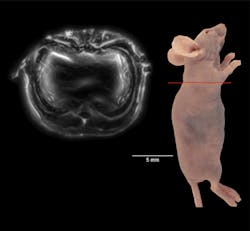Photoacoustic technique achieves high-res, full-body scans of small animals in real time
A team of researchers at the Optical Imaging Laboratory at the California Institute of Technology (Caltech; Pasadena, CA) used a photoacoustic technique to view the inner workings of a small animal with enough resolution to see active organs, flowing blood, circulating melanoma cells, and firing neural networks.
Related: Photoacoustic microscopy images functions in the living brain quickly
The technique, called single-impulse photoacoustic computed tomography (SIP-PACT), combines light and ultrasound to peer inside living animals. The researchers, led by Lihong Wang, the Bren Professor of Medical Engineering and Electrical Engineering, have shown that this hybrid imaging technology breaks the longstanding resolution and speed barriers in small-animal whole-body imaging. It provides a full cross-sectional view of a small animal's internal functions in real time.
"Photoacoustic imaging has been highly expected to get real-time whole-body imaging of a small animal with rich functional information," said Junjie Yao, an assistant professor of biomedical engineering at Duke University, who was an engineer in the Optical Imaging Laboratory when the research was conducted. "With this advance, researchers can easily watch as drugs are distributed throughout an animal and track how different organs respond."
Traditional light-based microscopy provides fast, high-resolution images that retain important functional information based on the wavelengths of light that the tissue absorbs, reflects, or emits. The significant amount of light that scatters as it travels through tissue, however, limits the depth of light microscopy to just a few millimeters.
Ultrasound waves easily travel through tissue, providing a much more in-depth view, but do not have the ability to read tissue's chemical components and miss much of the important information that light carries with it. Magnetic resonance imaging (MRI) can also see deep into tissue, but requires a strong magnetic field and often takes seconds to minutes to form an image. X-rays and positron emission tomography (PET) deliver too much radiation to the subject to be practical over long time periods.
Photoacoustic imaging uses powerful, but extremely short laser bursts that safely cause cells to emit ultrasound waves, which then travel unimpeded back through the tissue. The result is an imaging technique that can peer up to 5 cm into the typical biological tissue with sub-millimeter-level resolution while retaining the functional information provided by traditional optical microscopy. For example, melanin absorbs near-infrared light, while blood's reaction to light differs depending on how much oxygen it is carrying.
"This penetration range enables functional imaging of whole bodies of small animals. This capability is expected to enable all kinds of biological studies in small animals and to accelerate drug discovery," Wang says.
In a new paper describing the work, Yao and colleagues led by Wang add the highly desired speed and panoramic views to the imaging technology's repertoire. They have built a circular ultrasonic detector and a fast data-acquisition system that can triangulate the origin of an ultrasonic wave from anywhere within the body of a small animal. And with the help of a fast laser that operates within the safety limit, the upgraded device can image the full cross-section of an adult rat 50 times per second, providing detailed movies of its inner workings with 120 µm resolution.
In the paper, Yao and colleagues describe how they use these abilities to track cancerous melanoma cells traveling through blood vessels of a mouse. They also demonstrate the ability to watch entire neural networks firing in real time.
"This approach is especially powerful because it does not rely on the injection of any type of contrast agent," Yao says. "You can be sure that changes are not caused by foreign variables. We think that this technology holds great potential for both preclinical imaging and clinical translation."
Full details of the work appear in the journal Nature Biomedical Engineering; for more information, please visit http://dx.doi.org/10.1038/s41551-017-0071.
